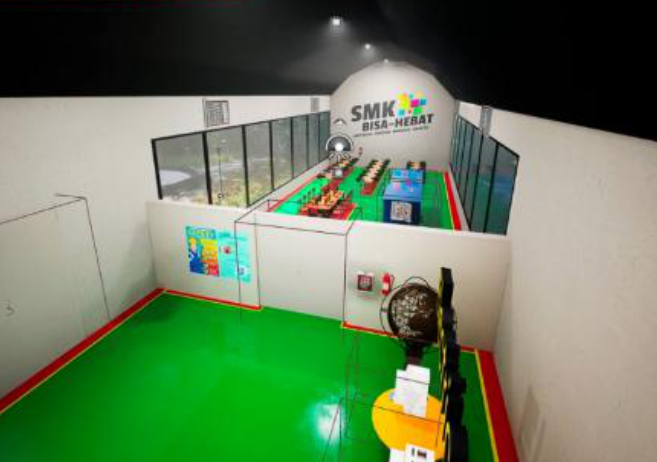Development of Virtual Reality-Based Electric Motor Control Simulation for Improving Electric Motor Installation Competency in Vocational High Schools

Downloads
Many vocational schools in Indonesia face limitations in laboratory facilities and practical equipment, which hinders students’ ability to master electric motor installation competencies. Virtual Reality (VR) offers a potential solution by providing safe, interactive, and cost-efficient learning environments that simulate real laboratory conditions. This study aims to develop and assess the feasibility of a VR-based electric motor control simulation as instructional media for vocational high schools. The novelty of this research lies in integrating pedagogical, ergonomic, and occupational safety aspects into VR learning, which are rarely addressed in previous studies. A Research and Development (R&D) approach was employed using a modified Waterfall model. Three-dimensional assets were created in Blender and implemented in Unreal Engine 5 to build immersive virtual environments. Validation was conducted by two media experts, two material experts, and 73 vocational students using questionnaires, observations, and pre/post-tests. The results showed feasibility scores of 68.53% from media experts and 79.58% from material experts, both categorized as feasible. Reliability analysis confirmed Cronbach’s Alpha values above 0.75, while student trials indicated significant learning improvement. These findings demonstrate that the developed VR simulation is feasible and effective as a pre-practical learning tool. In conclusion, this study contributes theoretically by extending VR pedagogy to safety-oriented vocational training and provides practical implications as an innovative solution for schools with limited resources.
Downloads
[1] Li, X., & Zhou, Y. (2021). Integrating VR and AR technologies for vocational skills assess-ment. Journal of Vocational Education and Training, 73(6), 963–981. https://doi.org/10.1080/13636820.2020.1825607
[2] Monteiro, P., & Rodrigues, J. (2020). Integrating VR in technical education: Pedagogical challenges and benefits. Education and Information Technologies, 25(5), 4273–4292. https://doi.org/10.1007/s10639-020-10183-2
[3] Burdea, G. C. (2003). Virtual reality technology (2nd ed.). John Wiley & Sons.
[4] Curcio, I. D. D., Dipace, A., & Norlund, A. (2016). Virtual realities and education. Research on Education and Media, 8(2), 60–68. https://doi.org/10.1515/rem-2016-0019
[5] Fernandez, M. (2017). Augmented virtual reality: How to improve education systems. Higher Learning Research Communications, 7(1), 1–15. https://eric.ed.gov/?id=EJ1150087
[6] Wu, C., Chen, S., & Lin, M. (2020). Virtual reality-assisted vocational training: A systemat-ic review. Educational Technology Research and Development, 68(6), 3355–3378. https://doi.org/10.1007/s11423-020-09824-2
[7] Zhao, Y., Tan, J., & Zhang, L. (2024). Immersive VR for technical skills training in voca-tional education. Computers & Education, 207, 104870. https://doi.org/10.1016/j.compedu.2024.104870
[8] Chen, X., & Huang, Y. (2021). Game-based virtual simulation for electrical engineering education. International Journal of Engineering Education, 37(5), 1253–1262.
[9] Li, H., & Wang, J. (2023). Ergonomic-based VR learning design for industrial safety train-ing. Education and Information Technologies, 28(4), 5121–5142. https://doi.org/10.1007/s10639-023-11847-8
[10] Prastawa, H., Mahachandra, M., & Waly, G. Z. (2023). Occupational safety and health risk assessment in an electronic manufacturing company in Indonesia. E3S Web of Con-ferences, 448, 01014. https://doi.org/10.1051/e3sconf/202344801014
[11] Lin, J., & Cheng, Y. (2023). Enhancing cognitive engagement in VR-based vocational train-ing. British Journal of Educational Technology, 54(2), 480–497. https://doi.org/10.1111/bjet.13272
[12] Kolb, D. A. (2015). Experiential learning: Experience as the source of learning and devel-opment (2nd ed.). Pearson Education.
[13] Ismara, K. I., & Prianto, E. (2017). How to create safe, healthy, and comfortable voca-tional laboratories. UNY Press.
[14] Aleksandrov, E. P. (2014). Use of audiovisual texts in the university education process. Universal Journal of Educational Research, 2(3), 252–255. https://doi.org/10.13189/ujer.2014.020308
[15] Montebello, M., & Camilleri, V. (2018). Employing virtual reality in academia. Interna-tional Journal of Information and Education Technology, 8(10), 736–741. https://doi.org/10.18178/ijiet.2018.8.10.1131
[16] Akrim, M. (2018). Media learning in digital era. Proceedings of AMCA 2018, 458–460. https://doi.org/10.2991/amca-18.2018.127
[17] Djouab, R., & Bari, M. (2016). An ISO 9126 based quality model for the e-learning sys-tems. International Journal of Information and Education Technology, 6(5), 370–375. https://doi.org/10.7763/ijiet.2016.v6.716
[18] Burdea, G. C., & Coiffet, P. (2003). Virtual reality technology (2nd ed.). John Wiley & Sons.
[19] Sun, H. (2023). Enhancing higher education English learning through VR and game-based approaches using the fuzzy deep model. Computer-Aided Design and Applications, 20(S14), 231–248. https://doi.org/10.14733/cadaps.2023.S14.231-248
[20] Nasrullah, M., & Rahim, F. (2024). Development of VR-based learning for automotive training. Journal of Technical Education and Training, 16(2), 150–166. https://doi.org/10.30880/jtet.2024.16.02.010
[21] Montebello, M., & Camilleri, V. (2018). Employing virtual reality in academia. Interna-tional Journal of Information and Education Technology, 8(10), 736–741. https://doi.org/10.18178/ijiet.2018.8.10.1131
[22] Curcio, I. D. D., Dipace, A., & Norlund, A. (2016). Virtual realities and education. Research on Education and Media, 8(2), 60–68. https://doi.org/10.1515/rem-2016-0019
[23] Li, M., & Zhang, J. (2025). Simulation-based learning effectiveness in electrical engineering education: A meta-analysis. IEEE Transactions on Education, 68(2), 155–166. https://doi.org/10.1109/TE.2025.3354781
[24] Ouyang, F., & Chang, Y. (2022). Pedagogical design in immersive VR for engineering edu-cation. Interactive Learning Environments, 30(6), 1101–1118. https://doi.org/10.1080/10494820.2020.1821718
[25] Fernandez, M. (2017). Augmented virtual reality: How to improve education systems. Higher Learning Research Communications, 7(1), 1–15. https://eric.ed.gov/?id=EJ1150087
[26] Wu, C., Chen, S., & Lin, M. (2020). Virtual reality-assisted vocational training: A systemat-ic review. Educational Technology Research and Development, 68(6), 3355–3378. https://doi.org/10.1007/s11423-020-09824-2
[27] Li, H., & Wang, J. (2023). Ergonomic-based VR learning design for industrial safety train-ing. Education and Information Technologies, 28(4), 5121–5142. https://doi.org/10.1007/s10639-023-11847-8
[28] Zhao, Y., Tan, J., & Zhang, L. (2024). Immersive VR for technical skills training in voca-tional education. Computers & Education, 207, 104870. https://doi.org/10.1016/j.compedu.2024.104870
[29] Ouyang, F., & Chang, Y. (2022). Pedagogical design in immersive VR for engineering edu-cation. Interactive Learning Environments, 30(6), 1101–1118. https://doi.org/10.1080/10494820.2020.1821718
[30] Chen, X., & Huang, Y. (2021). Game-based virtual simulation for electrical engineering education. International Journal of Engineering Education, 37(5), 1253–1262

This work is licensed under a Creative Commons Attribution-ShareAlike 4.0 International License.
The Authors submitting a manuscript do so on the understanding that if accepted for publication, copyright publishing of the article shall be assigned to Journal.



















